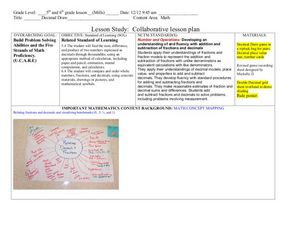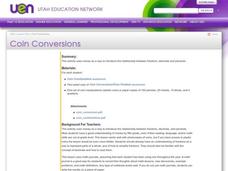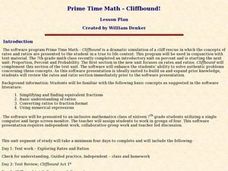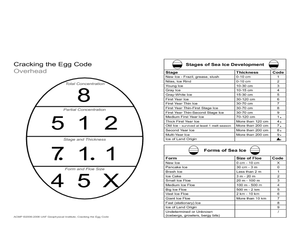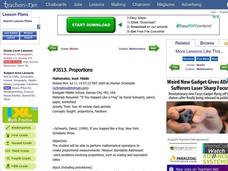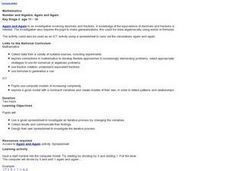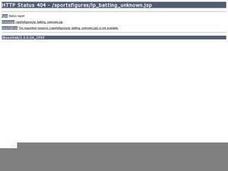Curated OER
Decimals: Collaborative Lesson
Students explore mathematics by participating in a group activity. In this number value lesson, students identify the uses for decimals and how to best estimate whole numbers based on decimals and fractions. Students collaborate with...
Curated OER
But That's Not FAIR!
Third graders solve problems using fractions through hands-on activities and appropriate literature.
Curated OER
Coin Conversions
Fifth graders engage in the study of conversions from decimals to percents while examining monetary values. They explain the relationships between the equivalency interchanging decimals with percents. Then students write about the...
Curated OER
Fuel Saving
Students explore the problem of percentages. Students find a given fraction or percentage of a quantity. Students devise and use problem solving strategies on problems explored.
Alabama Learning Exchange
Scaling Down the Solar System
Learners work collaboratively to gain a better understanding of the vastness of space by scaling down the solar system. They measure by inches, gain an understanding of space, and model the distances of the planets from the sun.
Curated OER
Introducing the Concept: Rates
Sixth graders explore rates as a specific type of ratio, using visual examples of unit rates and unit prices to increase comprehension. They also practice solving problems that are modeled by the instructor. The well-scripted lesson plan...
Curated OER
Fraction Message
Students practice identifying fractional parts represented in pictures and phrases. In this fraction lesson, students determine the proportion represented by common time and money phrases such as "3 hours in a day". Students match their...
Curated OER
Numbers and Operations
Students practice using proportions to discover the fraction needed to use the right amount of an ingredient. They calculate the number of ounces in one gallon as well. They answer questions to complete the lesson.
Curated OER
Wildlife Sampling-Capture-Recapture
Seventh graders simulate the capture-recapture method of population sampling using beans. In this biology instructional activity, 7th graders calculate the total population of beans in the bowl. They assess whether this method is...
Curated OER
Sea Ice: Unscrambling the Egg Code
Students determine sea ice thickness, concentration, and floe size by reading egg codes. In this sea ice conditions lesson, students color code a map based on prescribed criteria and use the maps to identify changes in sea ice...
02 x 02 Worksheets
Inverse Variation
Discover an inverse variation pattern. A simple lesson plan design allows learners to explore a nonlinear pattern. Scholars analyze a distance, speed, and time relationship through tables and graphs. Eventually, they write an equation to...
Curated OER
The Math of Renewable Energy
Students research additional information about questions on their worksheet. In this energy activity, students develop visual aids of their proposed solution to the problem. They present their work in class.
Curated OER
Prime Time Math
Seventh graders use educational software in order to practice lesson plan objectives. They define rate and ratio. Students solve distance problems given two variables. They also use a problem solving strategy that can be defended in its...
Curated OER
Sea Ice: Cracking the Egg Code
Pupils study the egg code to learn about sea ice. In this sea ice instructional activity, students discuss and view a diagram to learn about the egg code when describing sea ice and its thickness. Pupils work in groups to play a game...
Curated OER
More Pizzas and Things
Students are introduced to the problem by playing a guessing game of "I am a number, which is half of 6 and 6, what am I?" They explain their answers and see if anyone else had an alternate solution checking for reasonableness.
Curated OER
Working with Cuisenaire Rods In Mathematics
Fourth graders learn the numerical value of each underlined letter of the standard Rod Code and develop systematic usage for building new units.
Curated OER
A Recipe For Success
Sixth graders explore a relevant application of ratios and proportions. They apply this concept through guided practice and interactive feedback.
Curated OER
Exploring the Slopes of Parallel and Perpendicular Lines
Pupils calculate the slope of parallel and perpendicular lines.In this algebra lesson, students differentiate between parallel and perpendicular lines. They graph their lines using the slope of the equation.
Illustrative Mathematics
Voting for Two, Variation 2
John won the election, but by how much more? Your learners will calculate how many votes each candidate received in order to determine the difference. Use with other lessons provided in the series to practice different variations of this...
Curated OER
Proportion
Students investigate proportion and ratio. In this geometry instructional activity, students set up the ratios of proportions correctly and solve for the unknown. They relate it to word problems.
Curated OER
Proportions
Middle schoolers perform mathematical operations to create proportional measurements, after listening to the David Schwartz book, If You Hopped Like a Frog.
Curated OER
Number and Algebra: Again and Again
Students use a given spreadsheet to investigate an iterative process by changing the variables. They design their own spreadsheet to investigate the iterative process.
Curated OER
Stars and Stripes
Students design a United States flag using reasoning. They describe their design to make it easy for it to be duplicated. They share their designs with the class.
Curated OER
Batting the Unknown
Students use batting averages to provide a measure of a player's past success. They use Algebra to calculate required performance to improve the average. Students compare baseball batting statistics early in the season and late in the...
